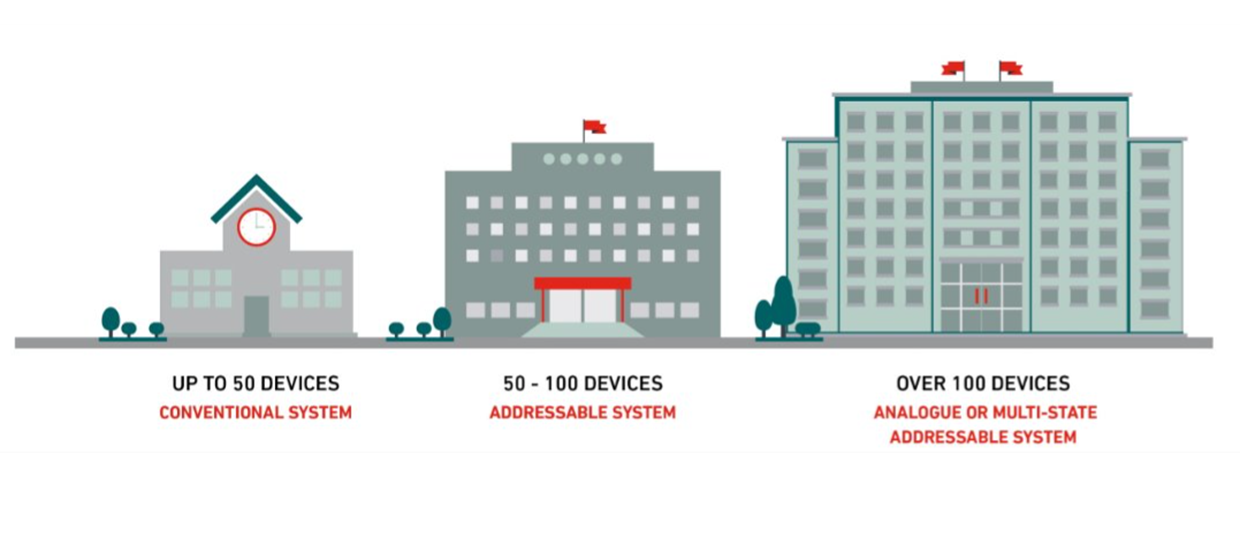
Protecting Educational Environments from Fire: A Comprehensive Guide for Industry Professionals
Educational settings host a large numbers of occupants, including children and young adults, many of whom may not be familiar with evacuation protocols or fire safety behaviours.
Ensuring fire safety in educational institutions is a unique and critical challenge. Schools, colleges, and universities are complex environments comprising classrooms, laboratories, sports halls, offices, kitchens, and sometimes residential accommodation.
Between 2023 and 2024, UK Fire and Rescue Services attended 522 primary fires in educational buildings across the country. Of these, it is estimated that 18% were started deliberately, and the consequences of even one uncontrolled fire can be devastating in terms of injury, property loss, service disruption, and long-term impact on a school’s community. It underscores the continued need for robust and responsive fire detection and alarm systems. In this article, we’ll explore the key considerations in designing, specifying, and maintaining such systems for educational premises, drawing not only from industry standards, but government guidance and practical experience.
Protocol Choices: Open vs Closed
One of the initial decisions when specifying a fire detection system is whether to adopt an open or closed protocol. Open protocol systems provide flexibility by allowing devices from different manufacturers to be used interchangeably. This offers potential cost savings, simpler upgrades, and increased options for future maintenance or expansion. Closed/managed protocol systems, on the other hand, limit integration to devices approved by the system manufacturer. While this can simplify commissioning and ensure compatibility, it often ties the customer to a single supplier for the lifetime of the system.
In educational estates, where Operational Expenditure (Opex) is vital, long-term planning, and scalability are key, open protocol solutions can be especially beneficial. However, the choice should be made based on site-specific needs. For example, existing infrastructure, future expansion plans, and maintenance capabilities need to be taken into account. It is also important to consider contractor familiarity and ongoing support capabilities when selecting the appropriate protocol.

Design Considerations: BS 5839-1:2025 and Fire Risk Assessment
BS 5839-1:2025 (updated from the previous version BS5839-1:2017) is currently being rolled out, and is the key British Standard that governs fire detection and alarm systems in non-domestic premises, including educational settings. It outlines system design principles, installation requirements, commissioning processes, and ongoing maintenance responsibilities. The standard encourages a risk-based approach to system design, which should be informed by a comprehensive Fire Risk Assessment (FRA).
The FRA must identify hazards, evaluate the risk to occupants, and assess existing control measures. It informs whether a Category L1 (Automatic Fire Detection (AFD)) Throughout), L2 (L3 plus AFD in additional defined areas not normally covered in L3, identified by RS), L3 (life protection in escape routes and areas off escape routes above 1m”), L4 (Escape Routes only, including Stairwells), M Manual – Manual Call Points and Bells or Sounders) system is required. In schools, where large numbers of people must evacuate quickly and safely, L1 or L3 systems are recommended most.
Designers must also consider audibility levels, visual alarms for hearing-impaired users, manual call point positioning, and the need for cause-and-effect programming—especially in larger or multi-building campuses.
With the upcoming revision to BS 5839-1 expected in 2025, duty holders and specifiers should remain aware of evolving best practices and regulatory expectations. A revision is likely put emphasis on enhanced integration with digital building systems and improvements in guidance for minimising false alarms – but this remains to be seen.
Estates Management: Good Practice Guidance
The Department for Education’s guidance on good estates management outlines the importance of planned maintenance, lifecycle costing, and a whole-site approach to infrastructure management. In terms of fire safety, this means ensuring that detection systems are regularly inspected, tested (weekly), and kept in a reliable condition (with a minimum of 2 fire maintenance visits per annum).
Asset registers, servicing schedules, and maintenance logs (in a logbook) should be maintained and reviewed regularly. Any changes to room usage or building layout should prompt a review of the fire alarm design in its entirety to ensure continued compliance and effectiveness. This focus on competence in the personnel responsible for fire systems is crucial — either through in-house expertise or reputable third-party contractors. A long-term maintenance plan helps avoid costly reactive repairs and ensures consistency across an estate, and when systems from multiple suppliers are installed without a coherent strategy, compatibility issues and inefficiencies can emerge.
BB100: Design for Fire Safety in Schools
Building Bulletin 100 (BB100) is a specific piece of guidance that provides design recommendations for both new builds and refurbishments, integrating the requirements of Building Regulations and health and safety legislation. BB100 advocates for automatic fire detection systems that are responsive but also tailored to the building’s occupancy and use. It recommends early consultation with the fire authority and insurance providers and stresses the need to align fire strategy with the school's operational requirements. Evacuation strategies must accommodate vulnerable users and allow for phased or zoned evacuation in complex settings.
Conventional vs Addressable Systems
Another critical consideration is the choice between conventional and addressable (analogue) fire alarm systems. Conventional systems divide buildings into zones, with detectors wired in circuits back to a control panel. When activated, the panel identifies the affected zone, but not the specific device. These systems are typically used in smaller schools or standalone buildings with simpler layouts.
Addressable systems, by contrast, assign each detector and call point a unique address. The control panel can display the exact location of the triggered device, enabling quicker response and more efficient management. These systems are ideal for larger or more complex educational facilities, requiring networking and/or complex cause and effect e.g. for phased evacuations, including multi-storey or campus-style environments. They offer better false alarm management, advanced diagnostics, and integration with building management systems.
When selecting a system type, budget, scale, and long-term operational goals should be weighed against initial installation complexity and training requirements.

Zoning for Effective Management
Zoning is essential in educational premises for effective fire alarm response and evacuation, and it should reflect the building’s layout and use—separating areas such as classrooms, kitchens, laboratories, and assembly halls.
BS 5839-1 recommends that each zone should not exceed 2000 m², and different floors should be separate zones. Clear labelling on the fire alarm panel and accurate zone drawings are critical for quick interpretation during emergencies. In addressable systems, ‘virtual zoning’ can be used to display groups of devices, providing even more granularity in large or complex sites.
Zoning also facilitates staged evacuation strategies, allowing for phased responses to minimise disruption and avoid overcrowding of escape routes.
Alarm Notification Devices and Manual Call Points
Alarm notification is central to ensuring that building occupants are alerted quickly and clearly. Sounders, visual alarm devices (VADs), and voice alarms should be selected based on the building’s needs. In educational settings, the challenge is to ensure that alarm signals are distinctive and intelligible without causing undue panic or disruption.
As an example, devices such as the Open Area Audio Visual (OAAV) range from Apollo features adjustable sound levels across seven settings and includes a bell tone option that can double for class change notifications. Devices like these are adaptable to various site challenges, offering flexible and practical notification solutions suitable for diverse environments within an educational estate. Familiarity with tones used for both routine and emergency alerts can support a calm and measured response when real alarms occur.
Manual call points should be installed at exits to an ultimate place of safety and exits on escape routes e.g. stairwells or at a change of level. BS 5839-1 recommends that no one should have to travel more than 45 metres to reach a call point, or 25 metres in areas with high risk. And, to reduce misuse or accidental activation, call points can be fitted with protective covers.
Mitigating False Alarms
False alarms are a significant issue in educational environments. Not only disrupting teaching, causing unnecessary evacuations, and desensitising staff and students to genuine alerts, but also taking the Fire Service away from incidents where they may be genuinely required to save lives. False alarms continue to be an issue that educational premises are all too familiar with.
Most unwanted fire signals (UwFS) in schools are due to dust, aerosols, or steam activating smoke detectors. Design stage decisions play a major role in mitigating these incidents. Appropriate detector types (e.g., heat detectors in kitchens or optical beam detectors in sports halls) and placement (avoiding bathrooms or areas with airborne particles) can drastically reduce nuisance activations.
Many addressable systems also offer false alarm management tools, such as pre-alarm warnings, multi-sensor discrimination, and adjustable sensitivity thresholds. Regular maintenance, including cleaning and testing of detectors, is essential. It should also be advised that staff training and clear policies on behaviour around detectors (e.g., avoiding aerosol sprays and managing the rising use of vapes in schools) also contribute to a reduction in false alarms.
Installing alarm confirmation delays in lower-risk areas, or using dual-sensor detectors in multi-use spaces, can also help prevent unnecessary evacuations. Coordinated fire drills can then reinforce appropriate responses to alarms, helping occupants distinguish between genuine alerts and known test procedures.

Conclusion
Designing and maintaining effective fire alarm systems in educational environments requires a tailored approach that balances regulatory compliance, risk assessment outcomes, operational requirements, and practical site considerations. From protocol choices and system types to zoning, alarm devices, and false alarm mitigation, each aspect must be carefully thought through.
The combination of BS 5839-1, BB100, and good estates management guidance provides a robust framework for ensuring safety in schools, colleges, and universities. By investing in appropriate systems and following best practices, duty holders can not only meet their legal responsibilities but also create a safe and secure environment in which education can thrive.
As we look ahead, continued innovation in fire detection technology with informed design and diligent maintenance will remain essential to safeguarding our educational infrastructure against fire risk. Through collaboration between system designers, school estates teams, fire services, and industry professionals, we can ensure that the next generation of learners is protected by the very best that modern fire safety has to offer.
Apollo Fire Detectors is proud to offer continuous professional development to those in the industry. Get in touch with the team via the button below to contact a member of the team, or visit https://www.apollo-fire.co.uk/training-support/ for free training and support.